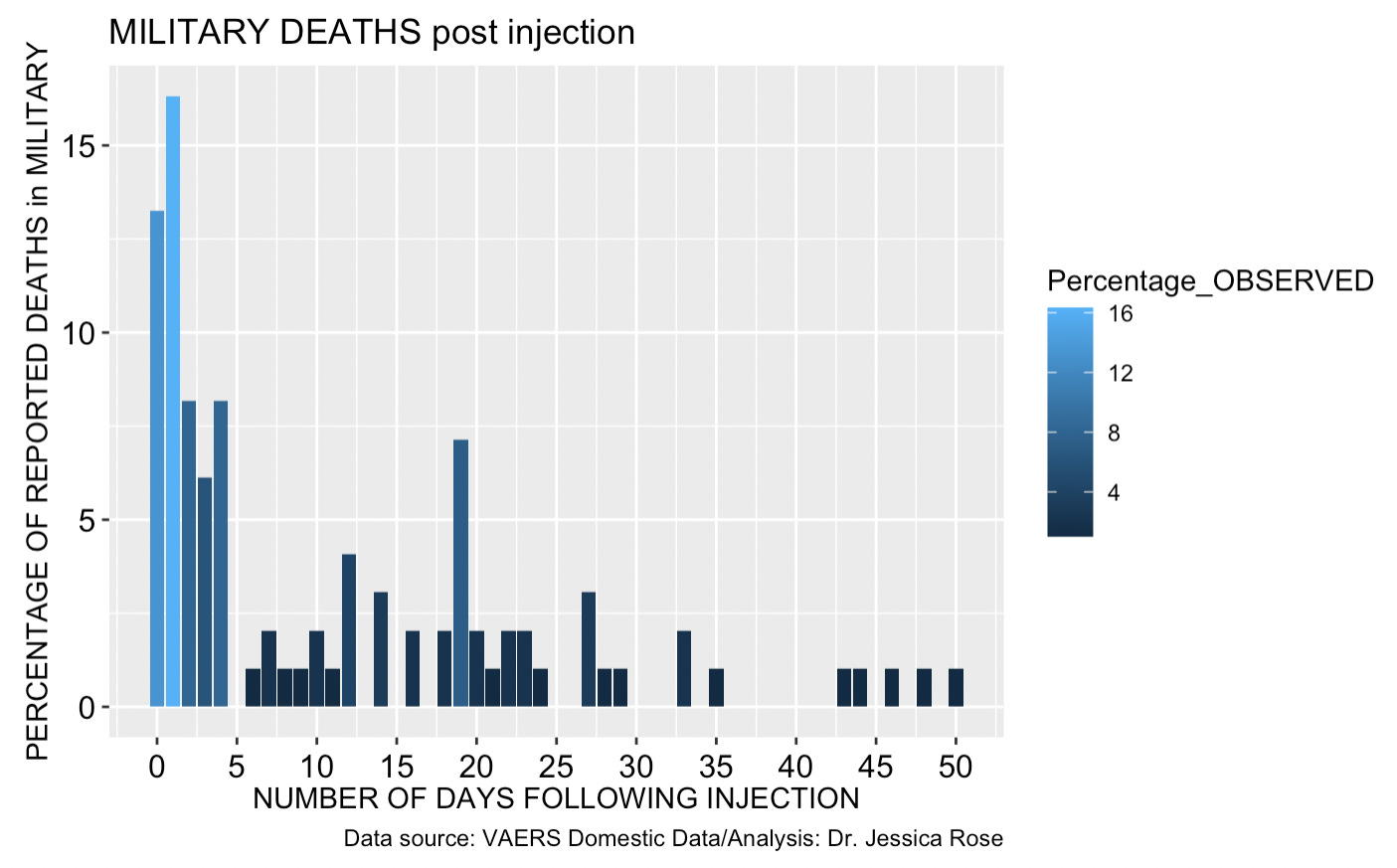I was just exchanging emails with my friend Jessica Rose in the middle of the night while working feverishly on a report. She is my VAERS go-to source for stats, which she writes about often. You know…because she's one of those weirdos who thinks it's important to understand the effects of the contents in the syringe, which makes her an anti-syringer according to post-2018 copies of Webster's Fictionary.
Something frightening struck me about the VAERS data she emailed me. There are approximately 126,000 people serving in the U.S. military age 40 or above, and many of those are in positions of leadership. VAERS reports, which are notoriously undercounted, have been submitted for 3.7% of them. And 23% of the 9,428 AEs reported to VAERS for military personnel are severe (this is a much higher reporting rate than the public indicating that VAERS is likely undercounting hundreds of thousands of serious AEs at the very least). If those serious AEs are spread evenly among the age groups, that means around 1062 of those age 40 or above have suffered serious adverse events during the mass experimental quasi-vaccine campaign. But the number is likely higher, perhaps even in excess of 1% of the senior military staff!
Judging by this actuarial table and a bit of envelope math, I'm guessing that the military typically sees 600 to 800 deaths in that age group annually. If you happen to see more specific numbers, by all means correct me. Let's just say 2 deaths per day among the 40+ cohort.
There are 119 reports of death for the military in VAERS. By proportion, 58 would be 40+, but in reality, the age curve for deaths in VAERS is very steep, much like that for COVID-19 itself, so the number is likely around 100. That seems conservatives low given the age distribution I found on Jessica's website.
Jessica also pointed out that 37% of those military deaths occurred within 72 hours of receiving a quasi-vaccine dose. She whipped up this distribution in the last email she sent me:
That would be 37 of the 100 deaths, give or take. But we would only expect 6 people to die in that span. I think we just showed that around 31/37 = 84% of VAERS death reports received within 72 hours of vaccination are vaccine-induced. And that puts a minimum of 31% of all VAERS deaths as vaccine-induced. It would make more sense if a large proportion of those between 72 hours and 7 days were also vaccine induced, so my intuitive sense of the above distribution is that the number is likely closer to 60% than other round numbers.
Edit: If we count all parts of the above distribution above 2, we get to around 50%, so we could call 50% “the floor” if we like. I still like 60% or maybe a bit higher as the causal proportion for this cohort.
So, have 60% of 119 (around 71) people in the military died due to experimental COVID-19 vaccines?
This may even be an underestimate given that military reporting is higher per capita than for the rest of the U.S., and when fewer reports are filed, we should expect the ones that do get filed to have clearer perceived association with vaccination.
But remember—VAERS report updates are not public, so many more than that may have died who filed reports after suffering serious adverse events. Also, underreporting is a notorious feature of VAERS. In fact, if deaths were reported the way they are required by law, there would necessarily be a minimum of hundreds of thousands of additional death reports in VAERS, whether or not they are causal. But for the sake of argument, let us ask the question:
Is it possible that 60 members of the U.S. military's 40+ population died due to vaccination?
This would be out of roughly 90% x 2 x 126,000 + boosters = maybe 300,000 doses?
That comes to 1 death per every 300,000/60 = 5,000 doses within an age-restricted cohort with few extreme elderly (but more people flying often, meaning excess risk of blood clots). Is that reasonable?
Recall various estimates that a death occurs in 1 in 2300 doses (over the whole age distribution).
Understand that this is a mix of real numbers and envelope math, but the point is a serious one, with some serious evidence.
Obligatory reminder of where arrogant ambition of leadership sometimes diverts itself:
Are the adults in the room too busy lining up for CRISPR life extension? Does that square with an oath to serve the nation?









The 1% AE's after vaccination is very worrying. Do you have any indication in what timespan after vaccination those AE's occur? It could even be worse than this as an AE seveal months after the vaccination often will not be related to the vaccin. The Guardian wrote a few days back about the increase in people on social security in the UK from long term sickness. The accompanying graph showed it starting to increase since last July/August. If this is from AE we might be looking at a public health disaster.
(The article is here https://www.theguardian.com/business/live/2022/feb/15/uk-pay-growth-lagging-inflation-vacancies-unemployment-stock-markets-oil-ukraine-business-live?page=with:block-620b85788f08d2c32d5a617e&filterKeyEvents=false#liveblog-navigation and you have to scroll down a bit)
walla